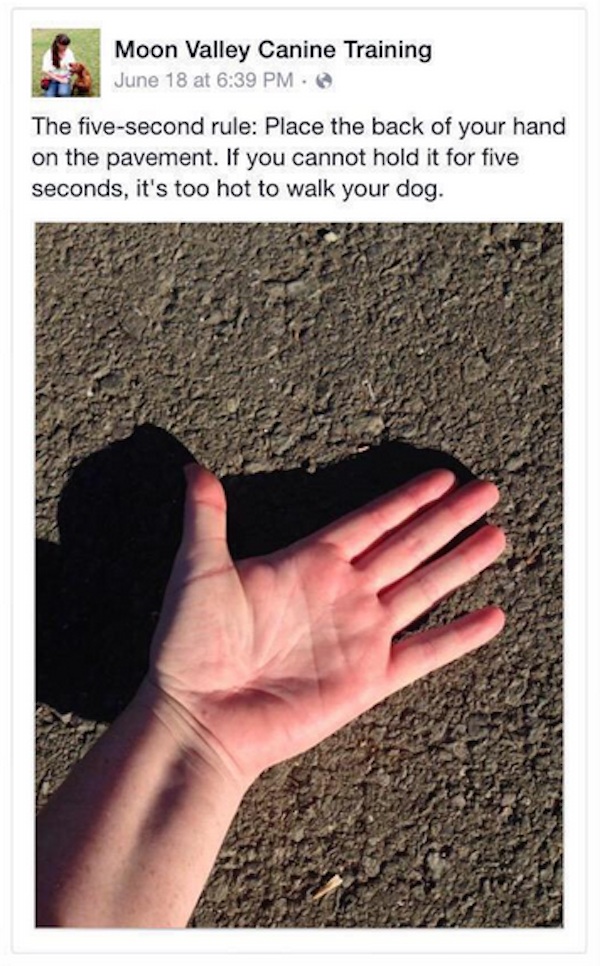Temperatures are soaring, and the first day of summer is right around the corner. Here at The Pet Nanny, our Concord dog walking clients’ dogs are enjoying their daily walks, despite the arrival of yet another sizzling California summer. With happy, panting faces and waggy tails, our favorite pups refuse to let the heat ruin the fun.
Daily dog walks can reduce or maintain your dog’s healthy weight, and strengthen the body against disease and aging. Walks also provide opportunities for your dog to become well-socialized and satisfy his desire to explore.
Scorching summer heatwaves can take the fun out of daily walks. Many outdoor surfaces absorb heat and can burn the skin on your dog’s paw pads. Paw pad burns can be mild to severe and can require an emergency vet visit. The dog may feel pain in every step as they recover.
Use these tips to protect dog paws from hot pavement and prevent painful pad burns.
Use The Five-Second Rule

To test a surface for safety for your dog’s paw pads, Moon Valley Canine Training advised in a popular Facebook post to place the back of your hand to the pavement for five seconds.
If it quickly becomes unbearable, it will be painful for your dog to walk on. While your dog’s paw pads are thicker and tougher than human skin, they can feel temperature just like us. Their paw pads are just as vulnerable to burns and cracking.
Watch Your Dog For Signs Of Discomfort
When your dog encounters a hot surface, he may hop from foot to foot to avoid prolonged contact. He may pull you towards grass or refuse to take steps towards hot surfaces. Always pay close attention to your dog on walks, not only to assess his comfort level but to also truly enjoy spending time together.
Avoid Hot Surfaces
Therese from PetSitUSA used a heat gun to compare temperatures of different surfaces on a hot day. When the air temperature peaked at 102 degrees, cement areas with full sun reached 154 degrees, while blacktop was a sizzling 165 degrees. Dark surfaces retain the most heat, though even light sidewalks can be scorching.
Keep in mind on your next walk, surface temperatures can be over 40 degrees hotter than air temperatures.
Green grass is always cool and comfortable for your dog to walk on. Soil and dirt are also cooler than pavement. Watch out for dead, yellow grass; dry brush can stick your dog’s fur, and certain plants seeds and foxtails can become embedded in your dog’s skin.
Use Dog Booties
You can use dog boots or shoes to protect your dog’s paws from hot pavement. Most dogs take a while to get used to wearing them and may find them uncomfortable in the summer. Unlike humans, dogs can only sweat from their noses and paws. Since they have such little surface area for cooling, paw booties can make it more difficult for your dog to tolerate the heat.
Get Doggy Socks
Dog socks stretch over your dog’s paws, and usually have rubber for traction on the bottom of the paw pads. This rubber can help protect your dog’s paws. The stretchy sock fabric may be more breathable than dog booties. They also take some getting-used-to but are generally easier for your dog to learn to wear than booties. Baby socks can work as doggy socks if you can find the right size. You can also find dog socks at the Concord PetSmart.
Use Invisible Booties
Mushers use a wax-based protection to keep their sled dogs safe from ice and snow. You can use the same wax to protect your dog’s paws when you’re unable to avoid hot pavement. Protective paw wax is available online or in pet stores. Try Musher’s Secret or Pawtector. Paw wax also conditions dry, cracked paws when used regularly.
Take Early & Late Walks
The pavement is hottest around 1 PM to 4 PM, and the temperatures quickly drop after that. Take advantage of crisp, cool mornings and warm summer nights, and avoid walking during midday.
Connect With Us!
For more dog care tips from The Pet Nanny, be sure to Like us on Facebook or subscribe to our email list.

